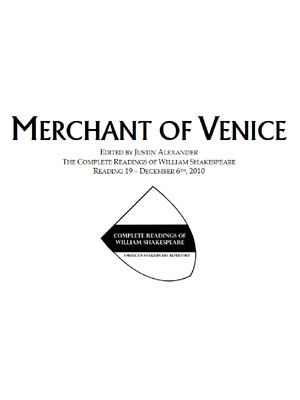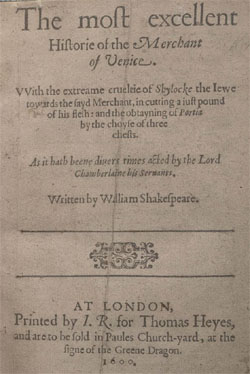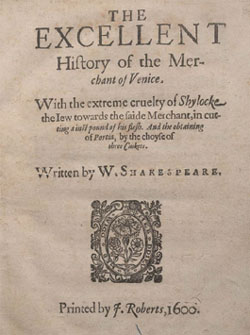 As with the other ASR scripts prepared for the Complete Readings of William Shakespeare, the full script presents the complete play. The conflated script, on the other hand, is what we use in actual performance. The conflated script is uncut, but does contain the role conflation which allows us to perform plays which have 30-50 roles with casts of 10-15 actors.
As with the other ASR scripts prepared for the Complete Readings of William Shakespeare, the full script presents the complete play. The conflated script, on the other hand, is what we use in actual performance. The conflated script is uncut, but does contain the role conflation which allows us to perform plays which have 30-50 roles with casts of 10-15 actors.
MERCHANT OF VENICE – FULL SCRIPT
MERCHANT OF VENICE – CONFLATED SCRIPT
The textual history of The Merchant of Venice, while paling in comparison to the tangle of Hamlet, is nevertheless something of a muddle. The confusion in this case arises almost entirely from the relationship between the First Quarto and Second Quarto of the play, both of which, according to the title pages, were printed in 1600:
Editors studying both of these quartos noted that the text we now refer to as the Second Quarto (Q2) appeared to be a superior text in that it corrected several errors found in the First Quarto (Q1). Two theories were postulated to explain the relationship between the texts: First, that Q1 was published first and, when the book went back to press for Q2, errors were corrected. (Possibly a fresh print run was ordered because of the errors.) Second, that Q2 was published first and, when it sold out, a new print run was either hastily ordered, typeset from Q2, or both (introducing fresh errors).
(In order to maximize the confusion, the Q2 -> Q1 version of the theory proved most popular and so, for a very long time, the texts were actually referred to using the opposite numbers: The text we now refer to as Q1 was called Q2; the text we now refer to as Q1 was Q2.)
As it happens, neither of these theories were true.
The truth was ferreted out in the early 20th century by Alfred W. Pollard, W.W. Greg, and William J. Neidig. In 1619, the publishers William Jaggard and Thomas Pavier printed new editions of 10 Shakespeare plays. For reasons which are not entirely clear, but which probably have a lot to do with the fact that they didn’t actually have legal right to publish all of these plays, Jaggard and Pavier printed many of these books with false title sheets claiming earlier publication dates and different publishers.
You can see where this is going: The Q2 of The Merchant of Venice was, in fact, one of the books published as part of the “False Folio” or “Pavier Quartos” (as these volumes have come to be known).
Once the truth came out, the textual history of The Merchant of Venice became a lot easier to figure out: Q1 had been published in 1600 (from either an authorial draft or a scribal copy); Q2 had been published in 1619 (from Q1); and the First Folio text had been published in 1623 (most likely from Q1, but including additional stage directions suggesting the copy may have been used as a theatrical prompt book).
LEGACY OF THE PAVIER QUARTOS
Intriguingly, the Pavier Quartos may have been responsible for the First Folio getting published. William Jaggard, responsible for printing the Pavier Quartos, was contracted just two years later to begin work on the folio. But why would you select a printer who had just attempted (or succeeded?) in pirating Shakespeare’s work?
Possibly because Jaggard had one of the few print shops capable of handling a book of the First Folio’s size. But also possibly because people who wanted to see Shakespeare’s works back in print didn’t care if Jaggard was ripping off somebody who owned the printing rights to a play but hadn’t done anything with it for nearly two decades. (For example, J. Heyes owned the printing rights to The Merchant of Venice… but it hadn’t been reprinted since 1600.)
The Pavier Quartos were also likely the first attempt to publish a collected edition of Shakespeare’s work. (One theory is that the works were released as separate volumes only after the project collapsed. All of the title sheets, for example, were printed at the same time.) Although Ben Jonson’s complete works had been published as a folio volume in 1616, attempts to collect the works of other playwrights had failed (and would continue to fail until Shakespeare’s First Folio was published in 1623). In fact, it may have been the exact same people coordinating both attempts.
Or even if that isn’t true, the publication efforts around the Pavier Quartos did have the effect of concentrating the printing rights of many Shakespeare plays into Jaggard’s control. Without that first step, the final collection of printing rights which allowed the First Folio to exist at all might not have been possible.
The truth is that we will probably never have the facts necessary to untangle what, exactly, was going on in 1619. But the few documentary trails which remain paint a delightfully convoluted picture of intrigue, conspiracy, and literary piracy.
LEGACY OF THE MOBY SHAKESPEARE
The muddled textual history of The Merchant of Venice, however, does highlight a modern oddity of Shakespeare’s plays.
If you search the internet for a Shakespeare play, you’ll find versions of it scattered around on hundreds of different sites. But virtually all of these texts are derived from the Moby Shakespeare.
The Moby Project is a collection of public domain lexical resources, many of which are now mirrored by Project Gutenberg. In 1995, the Moby Project released an ASCII text version of the Complete Works of William Shakespeare. This text, in turn, was derived from the 1866 Globe Shakespeare. The Globe Shakespeare was selected because (a) it was in the public domain and (b) it served as a standard reference document for Shakespearean studies for more than 100 years due to its immense popularity. (For example, its line numbering was used by the Norton Facsimile Edition of the plays, which means it’s still the standard line numbering used in virtually all scholastic papers.)
But the Globe Shakespeare naturally couldn’t benefit from any of the advances in scholastic techniques or bibliographic knowledge in the 150 years since it was published. And therefore the Moby Shakespeare didn’t benefit from them. And because the Moby Shakespeare is now all-pervasive on the internet, it’s having the interesting effect of rolling back decades of scholastic research.
Take The Merchant of Venice, for example: When the Globe Shakespeare was published, it was believed that Q2 was the most accurate of the original source texts in representing Shakespeare’s original text. We now know beyond a shadow of a doubt that this isn’t true, but we don’t have time machines, so the Moby Shakespeare (based on the Globe Shakespeare based on Q2) is simply wrong.
SEE ALSO
- Merchant of Venice: The Three Sallies
- Merchant of Venice: Elizabethans and the Jews
- Merchant of Venice: The Pound of Flesh
- Merchant of Venice: The Great Conversion
- Merchant of Venice: The Soul of Shylock
TEXTUAL PRACTICES
Source Text: First Quarto (1600)
1. Emendations from First Folio in <diamond brackets>.
2. Original emendations in [square brackets].
3. Speech headings silently regularized.
4. Names which appear in ALL CAPITALS in stage directions have also been regularized.
5. Spelling has been modernized.
6. Punctuations has been silently emended (in minimalist fashion).
7. The characters of “Salanio”, “Solanio”, “Salarino”, and “Salerio” have been corrected and regularized.
Originally posted on December 1st, 2010.













